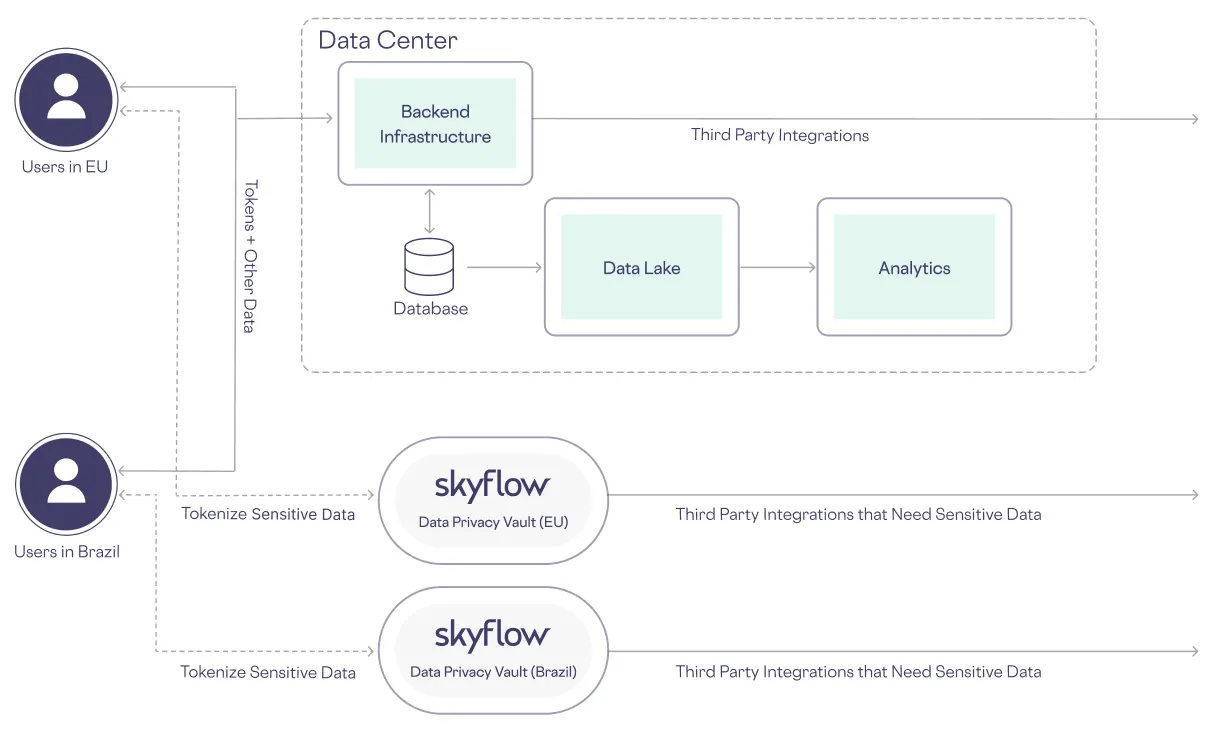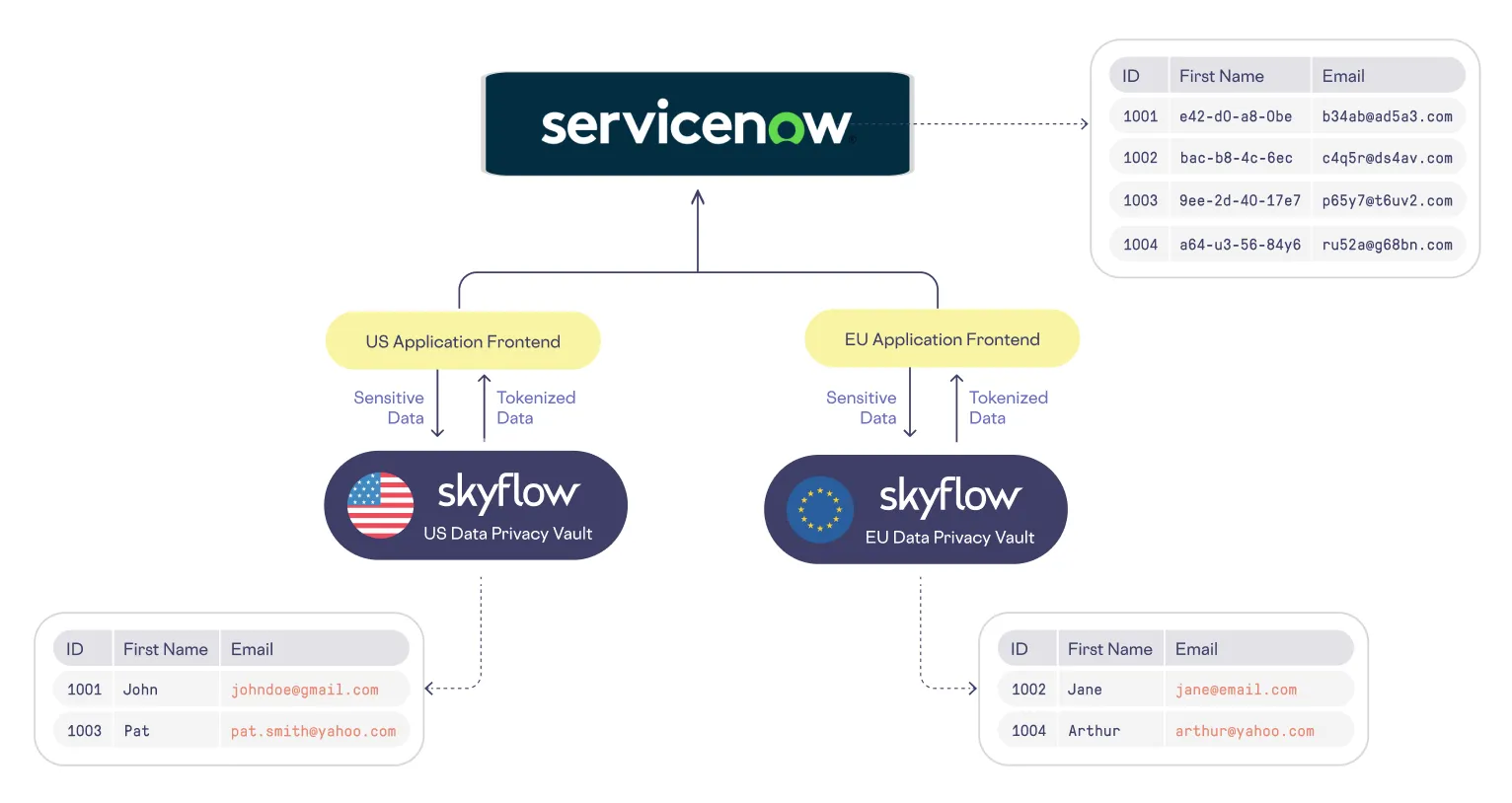What is Data Residency & How Can a Data Privacy Vault Help?
Data residency has emerged as a strategic imperative for global enterprises. With over 100 countries enforcing data localization laws, the complexity of managing sensitive data (PII included) across borders has grown exponentially. If you sell a product or service in multiple markets, you’ve probably encountered regulatory barriers already. Scaling a company up and expanding into a new market means planning ahead and finding ways to meet these regulatory requirements.
The mandate for technology leaders orchestrating their organizations’ global strategy is clear: Meet regulatory requirements by fulfilling regional compliance and have control and visibility into global operations. What does it take to balance these competing priorities? Read on to understand how these regulatory challenges impact your global technology and data strategy and how a vault-based approach offers a path forward on your journey to create a secure, compliant modern AI data stack.
What Is Data Residency?
Data residency is a central element of modern privacy laws. These regulations govern the location, control, and security of sensitive data that is collected or stored in a particular country, state, or region. From a user perspective, it is typically embodied in pop-up warnings or requests for consent to collect user data. From an engineering organization's perspective, it is a set of technical requirements that the business must meet to collect or use data in or from a new region.
The regulatory environment has grown increasingly complex, with significant developments including:
- Enforcement escalation: Regulators have issued over $1.2 B in privacy-related fines in 2024 alone
- Cross-border friction: The EU AI Act introduces new data processing and localization requirements
- Expansion into emerging markets: India's Digital Personal Data Protection Act (DPDP) and the enacted Indonesia's Personal Data Protection (PDP)
- Jurisdictional fragmentation: State-level privacy laws in the US create compliance complexity even within a single country
For CTOs, these regulations represent more than just compliance challenges - they create structural constraints on how global businesses architect their technology systems.
While some of these laws don’t have specific data storage or processing requirements, they all govern sensitive data collected within those regions. For example, GDPR doesn’t require that data collected in the EU be stored within the EU, but it does require that any sensitive data stored elsewhere is transferred only to a location that has regulations substantially similar to GDPR.
For Sensitive Data, Borders Matter More than Ever
As the above example indicates, becoming and staying compliant with data residency requirements can get very complicated, very fast. For example, entering a new market requires research of both current and future legislation, building the legislative requirements into the product or service, and ensuring that any sensitive data is being stored and processed in a compliant manner (and in a region that meets those residency requirements). Not only that, but this must be done in every jurisdiction where you do business.
This can become especially difficult for products and services that can be accessed or purchased from anywhere, such as a smartphone app. Not meeting the requirements of a particular piece of legislation could freeze a company out of that market, stymieing growth and potentially damaging their reputation. It could also impact brand reputation in other markets.
And even in cases that are less complex than supporting a global smartphone app, compliance can be very challenging. A simplistic approach to data residency compliance with geo-duplicated architecture in each region is expensive, hard to maintain, and lacks support for global analytics.
The following shows a geo-duplicated architecture for a company that operates in the EU and Brazil:

Data Residency: A Continuous Challenge
But costs, maintenance, and stunted analytics are just the start of the data residency issues created with geo-duplicated architectures.
Let’s say you’re marketing your products in multiple countries, collecting data that is protected in some regions and has local data storage requirements in others. If you’re already in multiple markets, this is probably a familiar situation. You have to devise a way to meet the protection rules for data you collect in all markets, while ensuring that you store that data within the regions that require local storage.
What makes this so challenging is the fact that modern cloud storage solutions aren’t typically set up with the level of granularity or storage flexibility needed to support this. You probably set your system up in compliance with the laws of your company’s “home” market, building pipelines that store all data in a single database or data lake in a cost-effective local datacenter, in compliance with local laws.
However, routing everything into the same data storage system doesn't work - some of that data needs to stay in the region where it was collected, and some of it needs to follow particular encryption, redaction, or anonymization rules.
Geo-Replication Has Serious Limitations
As shown above, you could roll up your sleeves and replicate your datacenter infrastructure in each market, setting up localized rules, storage procedures, and security measures, seeking out the most cost-effective data storage in each country or region, and ditching the simplicity of a single data storage solution for multiple purpose-built architectures in each current and future market. But this approach likely causes more problems than it solves.
A geo-replicated architecture enables operations in markets where you’re already operating, but expanding into new markets (even with just a single customer) requires new data center infrastructure, possibly with a unique architecture. And each local datacenter could require tweaks and adjustments as laws change. Making this even more complicated is the "federalization" of data privacy laws, with unique laws being written and enforced that span multiple countries, a single country, a single state within a country, and possibly even smaller jurisdictions, like counties and cities.
How to Meet Data Residency Requirements with Skyflow Data Privacy Vault
Skyflow Data Privacy Vault combines the essential elements of each approach, allowing locally compliant storage of all the data collected while giving granular control over where the data goes, what it is used for, how it is secured, and where it is stored. By protecting all sensitive data in the vault, Skyflow ensures that it is encrypted in transit, at rest, and in memory, meeting legislative requirements without limiting the usability of the data.
Our advanced data governance engine allows you to easily manage the complexity of multiple data residency laws, giving you highly granular control of each piece of data. Social security numbers or other government IDs collected in one country might require full redaction, while only partial redaction might be required in another, but you can easily account for this using Skyflow’s policy-based access control model (PBAC).
Finally, you can host one or more vaults anywhere in the world, allowing you to meet multiple residency requirements, set unique rules, and future-proof against legislative changes. Rather than building a unique datacenter architecture yourself in each new market, Skyflow gives you all the tools you need and keeps the data you collect where it needs to be, all while allowing you to use that data for insights and internal functionality.

ServiceNow’s Skyflow Integration to Ensure Data Residency Compliance
If you orchestrate business workflows with ServiceNow, you can leverage Skyflow's Data Privacy Vault as a seamless component of your data residency strategy.
For instance, let’s imagine that you are the CTO of a global final services company. Your teams use ServiceNow to orchestrate customer onboarding, support, and compliance workflows in every region you serve.
Your company needs to ensure that sensitive data, including PII and PCI collected from EU residents stays in the EU, and sensitive data collected from US residents stays in the US to meet various data residency requirements, including GDPR.
Integrating Skyflow’s Data Privacy Vault with ServiceNow creates a new approach for data residency compliance. This solution isolates customers’ sensitive data and stores it in region-specific Skyflow vaults while centrally orchestrating ServiceNow workflows with corresponding irreversible tokens. This gives teams the operational efficiency of a unified workflow platform while seamlessly meeting complex region-specific regulatory requirements.
This means your ServiceNow workflows can run globally, but the actual sensitive customer data never leaves its home country. Your teams can continue to use ServiceNow as usual, while Skyflow tackles data residency behind the scenes. This ServiceNow+Skyflow integration will allow you to grow in new markets by:
- Scaling business faster
- Reducing compliance headaches
- Avoiding costs and complexity of duplicating infrastructure
The following diagram illustrates how this data residency solution works:

Skyflow offers tailored vault deployments across key global markets, including the European Union, India, Japan, Australia, Indonesia, and the Middle East. Enterprises can meet regulatory requirements such as GDPR, DPDP, and PDP without duplicating their application environments or degrading user experience.
Skyflow's vault architecture integrates seamlessly with your enterprise technology stack, providing consistent data residency controls across your most critical business platforms:
- Cloud Data Platforms - AWS, Snowflake, Databricks
- Business Applications - Salesforce, HubSpot
- Integration Platforms - MuleSoft, Boomi
This integration strategy allows CTOs to implement a consistent data security, privacy and residency approach across the data infrastructure - reducing complexity while ensuring compliance.
Next Steps for CTOs
Whether you are gearing up to enter a new market or already juggling data residency laws, Skyflow Data Privacy Vault is an effective platform to help you meet any current or future legislative requirements. In fact, you can use Skyflow to protect sensitive data in Large Language Models (LLMs), so you can harness the potential of generative AI without sacrificing data privacy.
If you’d like to learn more about how Skyflow can help you, join us to learn more about How a Data Privacy Vault Simplifies Data Residency.
- Review your current global data architecture
- Identify specific compliance vulnerabilities
- Develop a roadmap for implementing Data Privacy Vault architecture with minimal disruption

